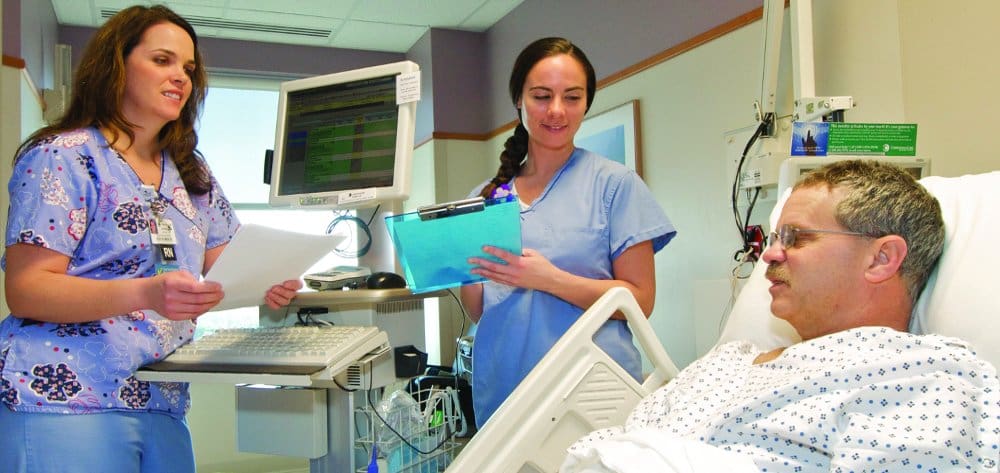I’m a floor nurse and charge nurse on a medical-surgical unit at a busy urban hospital. In the nearly 6 years I’ve worked on this unit, I’ve had many educational and training opportunities. One of my training projects was to implement bedside shift report on my unit—a project that eventually spread to all med-surg units and our sister facility. January 2013 marked the third anniversary of this successful implementation.
How the idea began
Tacoma General Hospital in Washington is part of the Multicare Health System. With its four hospitals and one children’s hospital, Multicare has more than 350 employed physicians, as well as multiple community clinics and specialty groups. To me, it seems like a big place and I feel like small cog. In 2008, I accepted an invitation to attend a weeklong conference on patient- and family-centered care. Seven of us flew to Boston—three staff nurses, two clinical directors, a family volunteer, and a physician from the children’s hospital. The conference was a real eye-opener. I’d never heard of some of the concepts and ideas presented—but I was sold on them. I knew I’d never look at nursing the same way.
Shortly after returning, a colleague and I were granted a 1-year fellowship through the Veterans Health Administration to learn about patient safety and implement a project to improve it. We knew we wanted to be more patient- and family-centered, and our research kept leading us to bedside shift reporting. At first, we both resisted the idea. But the more we thought about it, the more we knew this was the right project for us.
We spent much of 2009 doing research, reading articles (there weren’t many), and connecting with staff at other hospitals that had successfully implemented bedside shift report. Then we practiced this new way of reporting with other nurses who were willing to try it. We created scripting, wrote simple protocols, and videotaped simulated scenarios. My clinical director and chief nurse supported the project. I struggled to get nurses to agree to try bedside shift report—yet it was announced that this would be expected on all units. I never thought I’d see the day every nurse on every shift would do shift report at the bedside. Although I continued to believe in the idea, as the end of 2009 (and my fellowship) neared, I was doubting it would ever happen system-wide. I’d nearly given up hope.
Putting it into practice
Around this time, my unit was chosen to participate in the Transforming Care at the Bedside (TCAB) initiative sponsored by the Institute for Healthcare Improvement and the Robert Wood Johnson Foundation. In November 2009, I flew to Nashville with three other nurses from my unit, my unit manager, clinical director, and chief nurse executive to attend a weeklong conference on TCAB.
We came back full of energy and ideas. But soon it was Thanksgiving, then Christmas…. Things were going slowly. I went to work the first Monday in 2010 wondering how we’d ever force nurses to do report at the bedside when they clearly didn’t want to. But I was surprised to see Allie, my nurse manager, standing at the time clock, handing out forms to nurses and telling them whom they’d be pairing with for bedside shift report. My clinical director was at work, too, as well as our chief nurse executive, director of the patient- and family-centered care department, and director of patient education. These upper-management nurses followed staff nurses during report, offering advice and gently guiding them in the right direction.
This happened again at 3 p.m. (shift change) and every day for the next 2 weeks. I was ecstatic, couldn’t believe it was happening. I starting hearing nurses talk about how bedside shift report had helped avert problems and the need for rapid response calls and how it led to prompt dressing changes and replacement of empty I.V. bags.
Champions and management support
When I reflect on how this practice change occurred, I’m convinced that a change to evidence-based practice requires strong staff champions and strong management support, including support from the chief nurse and other department heads. We don’t work in a vacuum or in isolation. Nurses and managers must work together to transform how we provide health care. I realized I’d (selfishly) thought of bedside shift report as my idea rather than a TCAB idea. I was wrong.
I’m fortunate to work for a hospital system committed to transformational leadership and transforming health care. It has invested in a completely electronic medical record (including barcode medication scanning) and poured money and time into training and educating nurses on the latest evidence-based practices and how to implement them. Administrators encourage and solicit ideas from frontline staff. I want to use the tools provided to help me care for patients more safely and effectively.
Measuring outcomes
After we implement a change, we should measure outcomes to determine if it is making a difference. Many items can be measured to evaluate bedside shift report. Staff surveys can yield information on what nurses think about report: Are they getting and giving enough information? Are they doing reports on time?
Checking the unit’s Press Ganey scores before and after implementation is a good idea, too. (See Press Ganey scores: Before and after by clicking the PDf icon above.) Other ways to measure outcomes include evaluating call-light use at change of shift and analyzing rapid response calls, end-of-shift overtime, and patient complaints. After this data is gathered, it should be shared with the staff.
Realize, though, that it may not be easy to obtain some of this data. As a floor nurse, I found it difficult to gather and analyze data. Now, our management gathers a lot of data and posts it for staff. But I still think nurses should know how to find and analyze data themselves.
Will your unit be next?
Five years ago, I never dreamed I’d be helping to lead change on my unit. Our TCAB team has championed many changes and talked with nurses on other units about how to make a change. We’re lucky our managers are so supportive, giving us time off to attend conferences and making these changes part of our yearly evaluations. I hope this article inspires other nurses to make changes on their unit to increase efficiency and enhance patient safety. Don’t be afraid to try something different. Bedside shift report has improved our communication with patients and families—and that’s a good thing.
Selected references
Institute for Healthcare Improvement. Transforming care at the bedside. www.ihi.org/offerings/Initiatives/PastStrategicInitiatives/TCAB/Pages/default.aspx. Accessed January 8, 2013.
Young Y, Barhydt NR., Broderick S, Colello AD, Hannan EL. Factors associated with potentially preventable hospitalization in nursing home residents in New York State: a survey of directors of nursing.
J Am Geriatr Soc. 2010;58(5):901-7.
Visit www.AmericanNurseToday.com for a complete list of references.
Coleen Ferris is floor nurse/charge nurse on the medical-surgical unit at Tacoma General Hospital in Tacoma, Washington.



















1 Comment.
I have found that some things are purposefully being left out at bedside. Why just have nursing do bedside report? Lets have everyone talking in front of families and the patient. Maybe then someone will wonder why levophed is still running in their mothers arm and hurting. All because the culture TRYING to be adapted in one of CLABSI fear?